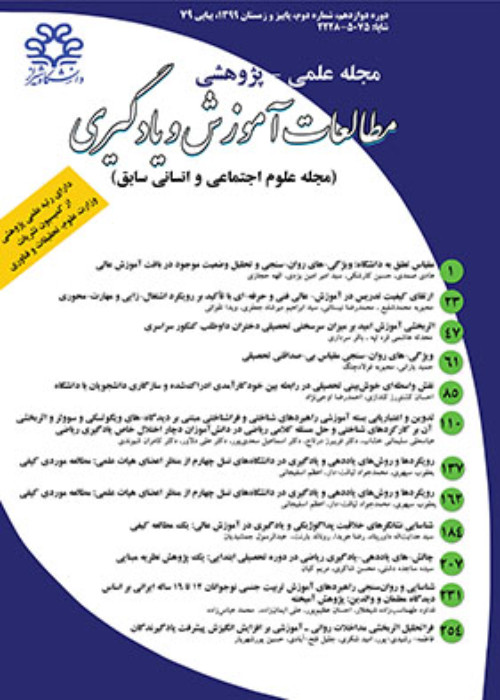Vandalistic Behaviors among High School Students: An inter-disciplinary Study Focusing on Social and Psychological Factors
Author(s):
Abstract:
Introduction Social pathology scholars define vandalistic behavior as behaviors turned towards destruction of the public assets, installations and properties (Mohseni Tabrizi, 2003; U.S. Department of Justice, 2014). Destructiveness by adolescents has been led into serious social problems. This issue catches scholar's attention of different disciplines, such as sociologists, psychologists and criminologists. Some sociologists believe that destruction of properties is a precursor of delinquent behaviors. Regarding these consequences, understanding the vandalism is vital for prevention and intervention (Mohseni Tabrizi, 2003). Vandalism is not limited to the school setting and is happening frequently and can disrupt the social order. Vandalism has a huge burden on the societys economy and cohesion (Motlagh and Ndari, 2013). However, it is a widespread phenomenon among adolescents (Koonani, Mansoor Abadi and Ahmadi, 2010), according to the literature, there are a variety of explanations for the causes of vandalism. A deep look at the existing theories on vandalism, can lead us to conclude that these theories, in order to explain social deviancies, and in particular vandalism, have common themes in their focus, with relatively different interpretations. Some of these common themes include the effect of social relationships, socialization, and existence of cohesion and unity with society, social trust, and quality of interactions in social networks, social accountability, and respect for social norms. These common points reveal the necessity for using a comprehensive and inter-disciplinary approach for studying vandalism. Thus, it is vital to investigate vandalism through an exploratory and applicable model. Therefore, the aim of the present research was to suggest a cross-disciplinary explanation for high school student's vandalistic behaviors by focusing on social and psychological factors. Accordingly, in this research the relationships between social capital, cultural capital, new communication technologies, attachment, and gender with vandalism in Kerman and Jiroft were investigated.
Hypotheses
1. There is a relationship between gender and vandalism.
2. There is a relationship between attachment to parents and vandalism.
3. There is a relationship between attachment to peers and vandalism.
4. There is a relationship between cultural capital and vandalism.
5. There is a relationship between using new communication technologies and vandalism.
6. Social capital mediates the relationship between gender, attachment, cultural capital, new communication technologies use and vandalism.
7. Urban versus rural backgrounds (Kerman vs. Jiroft) can moderate the mediated relationships among gender, attachment, cultural capital, the use of communication technologies and vandalism.
Method The relationship between variables was examined using the correlation research design and path analysis. Statistical population involves all students of Kerman and Jiroft highschools. Using cluster sampling, 806 participants were selected from Kerman (404) and Jiroft (402) high schools. The measures were Vandalism, Cultural Capital, Social Capital and New Communication Technologies Use questionnaires. In addition, Armsden and Greenberg's (1987) Inventory of Parent and Peer Attachment (IPPA) were used. The proposed Model was tested using structural equation modeling in AMOS software.
Results Results showed that the use of new communication technologies and attachment to parents had direct effects on vandalism. The use of new communication technologies positively and attachment to parents negatively can predict student's vandalistic behaviors. Also, the effects of all exogenous variables (cultural capital, new communicational technologies, parent attachment, peer attachment and gender) on student's vandalistic behaviors were mediated by the social capital. Other results showed that the moderating effect of urban milieu was significant and there was also a difference between Kerman's and Jiroft's participants and consequently models.
Discussion and Conclusions As noted above, the aim of present research was testing a causal model of explaning vandalism based on cultural capital, modern communicative technologies, attachment, and gender. Meanwhile, the moderator role of context has been investigated. The model revealed that social, psychological and contextual factors can approximately explain the students vandalistic behaviors. The model could explain 32 percent of the variance in vandalistic behaviors. Thus, it should be noted in generalizing and applying the results. Comparing Kerman and Jiroft as different social contexts imply notions of indigenized factors affecting vandalistic behaviors. It seems that a more traditional culture of Jiroft affected the participants in such a way that Jiroft participants were more influenced by family and internal factors than new communication technologies. Consequently, early interventions and preventive programs can reduce social pathologies and abnormal behaviors such as vandalism. In general, this research can suggest parents living in cities improve their relationships with their children through self-training or seeking help from professionals. Based on these results, it can be suggested that the cultural capital can be the source to prevent vandalistic behaviors. Hence, improving and investing on this capital will have significant effects on protecting the society. Significant role of gender in vandalism have implications to pay more attention to male adolescents behaviors in and out of school environment. Regarding inevitable effects of new communication technologies and the role of social capital in controlling and regulating of these effects, the study recommends teachers, principals and other administrators of the educational system to try to empower the student's social capital.
Hypotheses
1. There is a relationship between gender and vandalism.
2. There is a relationship between attachment to parents and vandalism.
3. There is a relationship between attachment to peers and vandalism.
4. There is a relationship between cultural capital and vandalism.
5. There is a relationship between using new communication technologies and vandalism.
6. Social capital mediates the relationship between gender, attachment, cultural capital, new communication technologies use and vandalism.
7. Urban versus rural backgrounds (Kerman vs. Jiroft) can moderate the mediated relationships among gender, attachment, cultural capital, the use of communication technologies and vandalism.
Method The relationship between variables was examined using the correlation research design and path analysis. Statistical population involves all students of Kerman and Jiroft highschools. Using cluster sampling, 806 participants were selected from Kerman (404) and Jiroft (402) high schools. The measures were Vandalism, Cultural Capital, Social Capital and New Communication Technologies Use questionnaires. In addition, Armsden and Greenberg's (1987) Inventory of Parent and Peer Attachment (IPPA) were used. The proposed Model was tested using structural equation modeling in AMOS software.
Results Results showed that the use of new communication technologies and attachment to parents had direct effects on vandalism. The use of new communication technologies positively and attachment to parents negatively can predict student's vandalistic behaviors. Also, the effects of all exogenous variables (cultural capital, new communicational technologies, parent attachment, peer attachment and gender) on student's vandalistic behaviors were mediated by the social capital. Other results showed that the moderating effect of urban milieu was significant and there was also a difference between Kerman's and Jiroft's participants and consequently models.
Discussion and Conclusions As noted above, the aim of present research was testing a causal model of explaning vandalism based on cultural capital, modern communicative technologies, attachment, and gender. Meanwhile, the moderator role of context has been investigated. The model revealed that social, psychological and contextual factors can approximately explain the students vandalistic behaviors. The model could explain 32 percent of the variance in vandalistic behaviors. Thus, it should be noted in generalizing and applying the results. Comparing Kerman and Jiroft as different social contexts imply notions of indigenized factors affecting vandalistic behaviors. It seems that a more traditional culture of Jiroft affected the participants in such a way that Jiroft participants were more influenced by family and internal factors than new communication technologies. Consequently, early interventions and preventive programs can reduce social pathologies and abnormal behaviors such as vandalism. In general, this research can suggest parents living in cities improve their relationships with their children through self-training or seeking help from professionals. Based on these results, it can be suggested that the cultural capital can be the source to prevent vandalistic behaviors. Hence, improving and investing on this capital will have significant effects on protecting the society. Significant role of gender in vandalism have implications to pay more attention to male adolescents behaviors in and out of school environment. Regarding inevitable effects of new communication technologies and the role of social capital in controlling and regulating of these effects, the study recommends teachers, principals and other administrators of the educational system to try to empower the student's social capital.
Keywords:
Language:
Persian
Published:
Studies in Learning & Instruction, Volume:9 Issue: 1, 2017
Pages:
23 to 49
magiran.com/p1732229
دانلود و مطالعه متن این مقاله با یکی از روشهای زیر امکان پذیر است:
اشتراک شخصی
با عضویت و پرداخت آنلاین حق اشتراک یکساله به مبلغ 1,390,000ريال میتوانید 70 عنوان مطلب دانلود کنید!
اشتراک سازمانی
به کتابخانه دانشگاه یا محل کار خود پیشنهاد کنید تا اشتراک سازمانی این پایگاه را برای دسترسی نامحدود همه کاربران به متن مطالب تهیه نمایند!
توجه!
- حق عضویت دریافتی صرف حمایت از نشریات عضو و نگهداری، تکمیل و توسعه مگیران میشود.
- پرداخت حق اشتراک و دانلود مقالات اجازه بازنشر آن در سایر رسانههای چاپی و دیجیتال را به کاربر نمیدهد.
In order to view content subscription is required
Personal subscription
Subscribe magiran.com for 70 € euros via PayPal and download 70 articles during a year.
Organization subscription
Please contact us to subscribe your university or library for unlimited access!




